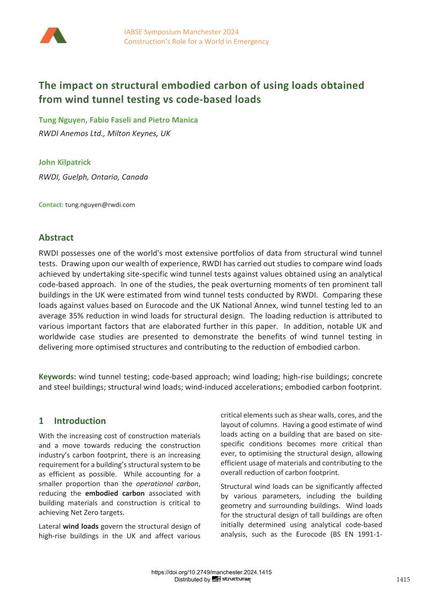The impact on structural embodied carbon of using loads obtained from wind tunnel testing vs code-based loads

|
|
|||||||||||
Détails bibliographiques
| Auteur(s): |
Tung Nguyen
(RWDI Anemos Ltd., Milton Keynes, UK)
Fabio Faseli (RWDI Anemos Ltd., Milton Keynes, UK) Pietro Manica (RWDI Anemos Ltd., Milton Keynes, UK) John Kilpatrick (RWDI, Guelph, Ontario, Canada) |
||||
|---|---|---|---|---|---|
| Médium: | papier de conférence | ||||
| Langue(s): | anglais | ||||
| Conférence: | IABSE Symposium: Construction’s Role for a World in Emergency, Manchester, United Kingdom, 10-14 April 2024 | ||||
| Publié dans: | IABSE Symposium Manchester 2024 | ||||
|
|||||
| Page(s): | 1415-1423 | ||||
| Nombre total de pages (du PDF): | 9 | ||||
| DOI: | 10.2749/manchester.2024.1415 | ||||
| Abstrait: |
RWDI possesses one of the world's most extensive portfolios of data from structural wind tunnel tests. Drawing upon our wealth of experience, RWDI has carried out studies to compare wind loads achieved by undertaking site-specific wind tunnel tests against values obtained using an analytical code-based approach. In one of the studies, the peak overturning moments of ten prominent tall buildings in the UK were estimated from wind tunnel tests conducted by RWDI. Comparing these loads against values based on Eurocode and the UK National Annex, wind tunnel testing led to an average 35% reduction in wind loads for structural design. The loading reduction is attributed to various important factors that are elaborated further in this paper. In addition, notable UK and worldwide case studies are presented to demonstrate the benefits of wind tunnel testing in delivering more optimised structures and contributing to the reduction of embodied carbon. |
||||
| Mots-clé: |
bâtiments hauts
|
||||
